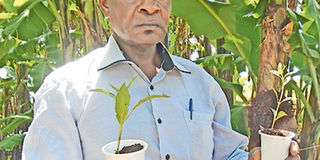Double rewards from farmer growing wonder crop stevia

Joseph Siango displays stevia seedlings in his farm in Nyamira. He sells each seedling at Sh50. PHOTO | FAUSTINE NGILA | NMG
What you need to know:
- As a natural sweetener, it is very healthy because it contains no calories.
- It is recommended for diabetic individuals and used in preventing lifestyle diseases and controlling obesity because one gets the sweetness without gaining calories.
- Carol Mutua, an expert from the Department of Crops, Horticulture and Soils at Egerton University, advises that stevia should be planted on raised beds at a spacing of 30cm between rows and 20cm between plants.
- On each acre, a farmer needs between 8,000 to 10,000 seedlings.
For six years, Joseph Siango’s life had been held back by the shackles of type 2 diabetes.
He was then advised to use stevia leaves in his tea and porridge daily, a step that he says helped him manage the disease.
It is the relief he got from the sweet leaf herb in 2009 that nudged him to start growing the crop.
Stevia leaves have a long history of use as sweeteners, due to presence of sweet crystalline glycosides called steviosides, which are 200 to 300 times sweeter than sucrose.
As a natural sweetener, it is very healthy because it contains no calories. Therefore, it is recommended for diabetic individuals and used in preventing lifestyle diseases and controlling obesity because one gets the sweetness without gaining calories.
“I was diabetic from 2003 to 2008 and could not take any sugary foods or drinks. But stevia leaves helped me,” says Siango, a resident of Gachuba village, Nyamira County.
To begin the venture, he leased a quarter acre of land after getting certified seeds from an international organisation, which buys the produce, says the 59-year-old.
For every kilo of harvested stevia, the organisation pays him Sh140, with an acre producing around 200kg.
Besides the sale of the leaves, he has now moved to growing the seedlings where buyers have to part with Sh50 for each.
Stevia stays in the seedbed for 30-40 days after which one can transplant to a well-tilled land whose soil is evenly drained.
In the seedbed, farmers are advised to water the seedlings twice a week, with regard to weather patterns. To achieve the required quality of natural sweetness, a good sunlight wavelength is required.
PLANTED ON RAISED BEDS
“Prepare one-foot cubic metre holes, add compost manure then plant your seedlings. After three months, your plants will have matured and ready for harvesting,” he says, adding that the plant can be harvested after every three months since the leaves sprout again after cutting.
Carol Mutua, an expert from the Department of Crops, Horticulture and Soils at Egerton University, advises that stevia should be planted on raised beds at a spacing of 30cm between rows and 20cm between plants.
“The field should be kept weed-free throughout the growing period. Organic farming is preferred in stevia production where manure is mainly used at a rate of 20 kilos per square metre,” she says.
She notes fertilisers can be used depending on soil fertility. NPK is used as a basal fertiliser while CAN for top dressing. Stevia is rarely affected by pests because it has insect-repellent properties, says the agronomist. “After harvesting for the fist time, you don’t need to purchase seeds again. You can plant the splits so long as they are not infected.”
On each acre, a farmer needs between 8,000 to 10,000 seedlings.
“The firm buys my produce each harvesting season and ships it to their factories where they use a solar dryer to get rid of all moisture. They then grind it into fine white pellets that are packed for sale to local supermarkets,” says Siango, adding a 150g pack of stevia powder is Sh995.
Mutua notes that stevia has dozens of health benefits that include regulating blood pressure, prevents diabetes by controlling insulin levels, preventing cancer, treating eczema and dermatitis, fighting gingivitis, preventing osteoporosis and aiding in weight loss.





